Lithium Manganese Sulfates as a New Class of Supercapattery Materials at Elevated Temperatures
Abstract
1. Introduction
2. Results and Discussion
2.1. Structural Characterization of Li2Mn(SO4)2 and Li2Mn2(SO4)3
2.2. Lithium Storage by L2M and L2M2
2.3. Sulfate Transformation during Cycling
3. Materials and Methods
3.1. Synthesis Procedure
3.2. Characterization Methods
3.3. Electrochemical Characterization
4. Conclusions
Author Contributions
Funding
Institutional Review Board Statement
Informed Consent Statement
Data Availability Statement
Conflicts of Interest
References
- Iqbal, M.Z.; Aziz, U. Supercapattery: Merging of battery-supercapacitor electrodes for hybrid energy storage devices. J. Energy Storage 2022, 46, 103823. [Google Scholar] [CrossRef]
- Balasubramaniam, S.; Mohanty, A.; Balasingam, S.K.; Kim, S.J.; Ramadoss, A. Comprehensive insight into the mechanism, material selection and performance evaluation of supercapatteries. Nano-Micro Lett. 2020, 12, 85–131. [Google Scholar] [CrossRef] [PubMed]
- Yu, L.; Chen, G.Z. Supercapatteries as high-performance electrochemical energy storage devices. Electrochem. Energy Rev. 2020, 3, 271–285. [Google Scholar] [CrossRef]
- Lander, L.; Tarascon, J.-M.; Yamada, A. Sulfate-based cathode materials for Li- and Na-ion batteries. Chem. Rec. 2018, 18, 1394–1408. [Google Scholar] [CrossRef]
- Gutierrez, A.; Benedek, N.A.; Manthiram, A. Crystal-chemical guide for understanding redox energy variations of M2+/3+ couples in polyanion cathodes for lithium-ion batteries. Chem. Mater. 2013, 25, 4010–4016. [Google Scholar] [CrossRef]
- Ni, Q.; Bai, Y.; Wu, F.; Wu, C. Polyanion-type electrode materials for sodium-ion batteries. Adv. Sci. 2017, 4, 1600275. [Google Scholar] [CrossRef]
- Barpanda, P.; Oyama, G.; Nishimura, S.; Chung, S.-C.; Yamada, A. A 3.8-V earth-abundant sodium battery electrode. Nat. Commun. 2014, 5, 4358. [Google Scholar] [CrossRef]
- Wong, L.L.; Chen, H.M.; Adams, S. Sodium-ion diffusion mechanisms in the low cost high voltage cathode material Na2+δFe2−δ/2(SO4)3. Phys. Chem. Chem. Phys. 2015, 17, 9186–9193. [Google Scholar] [CrossRef]
- Dwibedi, D.; Araujo, R.B.; Chakraborty, S.; Shanbogh, P.P.; Sundaram, N.G.; Ahuja, R.; Barpanda, P. Na2.44Mn1.79(SO4)3: A new member of the alluaudite family of insertion compounds for sodium ion batteries. J. Mater. Chem. A 2015, 3, 18564–18571. [Google Scholar] [CrossRef]
- Marinova, D.; Kostov, V.; Nikolova, R.; Kukeva, R.; Zhecheva, E.; Sendova-Vasileva, M.; Stoyanova, R. From krohnkite- to alluaudite-type of structure: Novel method of synthesis of sodium manganese sulfates with electrochemical properties in alkalimetal ion batteries. J. Mater. Chem. A 2015, 3, 22287–22299. [Google Scholar] [CrossRef]
- Singh, P.; Shiva, K.; Celio, H.; Goodenough, J.B. Eldfellite, NaFe(SO4)2: An intercalation cathode host for low-cost Na-ion batteries. Energy Environ. Sci. 2015, 8, 3000–3005. [Google Scholar] [CrossRef]
- Gao, J.; Sha, X.; Liu, X.; Song, L.; Zhao, P. Preparation, structure and properties of Na2Mn3(SO4)4: A new potential candidate with high voltage for Na-ion batteries. J. Mater. Chem. A 2016, 4, 11870–11877. [Google Scholar] [CrossRef]
- Reynaud, M.; Rousse, G.; Abakumov, A.M.; Sougrati, M.T.; Van Tendeloo, G.; Chotard, J.-N.; Tarascon, J.-M. Design of new electrode materials for Li-ion and Na-ion batteries from the bloedite mineral Na2Mg(SO4)2·4H2O. J. Mater. Chem. A 2014, 2, 2671–2680. [Google Scholar] [CrossRef]
- Barpanda, P.; Oyama, G.; Ling, C.D.; Yamada, A. Kröhnkite-type Na2Fe(SO4)2·2H2O as a novel 3.25 V insertion compound for Na-ion batteries. Chem. Mater. 2014, 26, 1297–1299. [Google Scholar] [CrossRef]
- Meng, Y.; Zhang, S.; Deng, C. Superior sodium–lithium intercalation and depressed moisture sensitivity of a hierarchical sandwich-type nanostructure for a graphene–sulfate composite: A case study on Na2Fe(SO4)2·2H2O. J. Mater. Chem. A 2015, 3, 4484–4492. [Google Scholar] [CrossRef]
- Marinova, D.M.; Kostov, V.V.; Nikolova, R.P.; Kukeva, R.R.; Zhecheva, E.N.; Stoyanova, R.K. Redox properties of alluaudite sodium cobalt manganese sulfates as high-voltage electrodes for rechargeable batteries. Chem. Commun. 2018, 54, 5466–5469. [Google Scholar] [CrossRef]
- Araujo, R.B.; Chakraborty, S.; Barpanda, P.; Ahuja, R. Na2M2(SO4)3 (M = Fe, Mn, Co and Ni): Towards high-voltage sodium battery applications. Phys. Chem. Chem. Phys. 2016, 18, 9658–9665. [Google Scholar] [CrossRef]
- Marinova, D.M.; Kukeva, R.R.; Zhecheva, E.N.; Stoyanova, R.K. Selective sodium intercalation into sodium nickel–manganese sulfate for dual Na–Li-ion batteries. Phys. Chem. Chem. Phys. 2018, 20, 12755–12766. [Google Scholar] [CrossRef]
- Wu, Q.; Xu, Y.; Ju, H. New-type low-cost cathode materials for Li-ion batteries: Mikasaite-type Fe2(SO4)3. Ionics 2013, 19, 471–475. [Google Scholar] [CrossRef]
- Manthiram, A.; Goodenough, J.B. Lithium insertion into Fe2(SO4)3 frameworks. J. Power Source 1989, 26, 403–408. [Google Scholar] [CrossRef]
- Isasi, J.; Train, C.; Jaulmes, S.; Elfakir, A.; Quarton, M. Crystal structure and magnetic properties of Li2Mn2(SO4)3. J. Solid State Chem. 2001, 158, 148–153. [Google Scholar] [CrossRef]
- Marinova, D.; Veselinov, K.; Kalapsazova, M.; Zhecheva, E.; Stoyanova, R. Structural transformation of Na2Mn2(SO4)3 alluaudite into orthorhombic Li2Mn2(SO4)3 induced after lithium intercalation. Mater. Today Proc. 2022, 61, 1260–1264. [Google Scholar] [CrossRef]
- Clark, J.M.; Eames, C.; Reynaud, M.; Rousse, G.; Chotard, J.-N.; Tarascon, J.-M.; Saiful Islam, M. High voltage sulphate cathodes Li2M(SO4)2 (M = Fe, Mn, Co): Atomic-scale studies of lithium diffusion, surfaces and voltage trends. J. Mater. Chem. A 2014, 2, 7446–7453. [Google Scholar] [CrossRef]
- Lander, L.; Reynaud, M.; Rousse, G.; Sougrati, M.T.; Laberty-Robert, C.; Messinger, R.J.; Deschamps, M.; Tarascon, J.-M. Synthesis and electrochemical performance of the orthorhombic Li2Fe(SO4)2 polymorph for Li-ion batteries. Chem. Mater. 2014, 26, 4178–4189. [Google Scholar] [CrossRef]
- Lander, L.; Reynaud, M.; Carrasco, J.; Katcho, N.A.; Bellin, C.; Polian, A.; Baptiste, B.; Rousse, G.; Tarascon, J.-M. Unveiling the electrochemical mechanisms of Li2Fe(SO4)2 polymorphs by neutron diffraction and density functional theory calculations. Phys. Chem. Chem. Phys. 2016, 18, 14509–14519. [Google Scholar] [CrossRef]
- Alzaid, M.; Iqbal, M.Z.; Alam, Sh.; Almoisheer, N.; Afzal, A.M.; Aftab, S. Binary composites of nickel-manganese phosphates for supercapattery devices. J. Energy Storage 2021, 33, 102020. [Google Scholar] [CrossRef]
- Soserov, L.; Marinova, D.; Koleva, V.; Stoyanova, A.; Stoyanova, R. Comparison of the Properties of Ni–Mn Hydroxides/Oxides with Ni–Mn Phosphates for the Purpose of Hybrid Supercapacitors. Batteries 2022, 8, 51. [Google Scholar] [CrossRef]
- Li, X.; Xiao, X.; Li, Q.; Wei, J.; Xue, H.; Pang, H. Metal (M = Co, Ni) phosphate based materials for high-performance supercapacitors. Inorg. Chem. Front. 2018, 5, 11–28. [Google Scholar] [CrossRef]
- Li, X.; Elshahawy, A.M.; Guan, C.; Wang, J. Metal phosphides and phosphates-based electrodes for electrochemical supercapacitors. Small 2017, 13, 1701530. [Google Scholar] [CrossRef]
- Kulkarni, A.A.; Savekar, V.A.; Bhat, T.S.; Patil, P.S. Recent advances in metal pyrophosphates for electrochemical supercapacitors: A review. J. Energy Storage Part B 2022, 52, 104986. [Google Scholar] [CrossRef]
- Samigullin, R.R.; Zakharkin, M.V.; Drozhzhin, O.A.; Antipov, E.V. Thermal stability of NASICON-type Na3V2(PO4)3 and Na4VMn(PO4)3 as cathode materials for sodium-ion batteries. Energies 2023, 16, 3051. [Google Scholar] [CrossRef]
- Zhou, Y.; Zhang, X.; Liu, Y.; Xie, X.; Rui, X.; Zhang, X.; Feng, Y.; Zhang, X.; Yu, Y.; Huang, K. A high-temperature Na-ion battery: Boosting the rate capability and cycle life by structure engineering. Small 2020, 16, e1906669. [Google Scholar] [CrossRef]
- Kalapsazova, M.; Markov, P.; Kostov, K.; Zhecheva, E.; Nihtianova, D.; Stoyanova, R. Controlling at elevated temperature the sodium intercalation capacity and rate capability of P3-Na2/3Ni1/2Mn1/2O2 through the selective substitution of nickel with magnesium. Batter. Supercaps 2020, 3, 1329–1340. [Google Scholar] [CrossRef]
- Kalapsazova, M.; Kostov, K.; Zhecheva, E.; Stoyanova, R. Hybrid Li/Na ion batteries: Temperature-induced reactivity of three-layered oxide (P3-Na2/3Ni1/3Mg1/6Mn1/2O2) toward lithium ionic liquid electrolytes. Front. Chem. 2020, 8, 600140. [Google Scholar] [CrossRef] [PubMed]
- Lee, J.; Srimuk, P.; Fleischmann, S.; Su, X.; Hatton, T.A.; Presser, V. Redox-electrolytes for non-flow electrochemical energy storage: A critical review and best practice. Prog. Mater. Sci. 2019, 101, 46–89. [Google Scholar] [CrossRef]
- Chawla, N.; Bharti, N.; Singh, S. Recent advances in non-flammable electrolytes for safer lithium-ion batteries. Batteries 2019, 5, 19. [Google Scholar] [CrossRef]
- Pasquier, A.D.; Plitz, I.; Gural, J.; Badway, F.; Amatucci, G.G. Power-ion battery: Bridging the gap between Li-ion and supercapacitor chemistries. J. Power Source 2004, 136, 160–170. [Google Scholar] [CrossRef]
- Hu, X.; Deng, Z.; Suo, J.; Pan, Z. A high rate, high capacity and long life (LiMn2O4+AC)/Li4Ti5O12 hybrid battery–supercapacitor. J. Power Source 2009, 187, 635–639. [Google Scholar] [CrossRef]
- Giiffin, G.A. Ionic liquid-based electrolytes for “beyond lithium” battery technologies. J. Mater. Chem. A 2016, 4, 13378–13389. [Google Scholar] [CrossRef]
- Feng, J.; Wang, Y.; Xu, Y.; Sun, Y.; Tang, Y.; Yan, X. Ion regulation of ionic liquid electrolytes for supercapacitors. Energy Environ. Sci. 2021, 14, 2859–2882. [Google Scholar] [CrossRef]
- Chagas, L.G.; Jeong, S.; Hasa, I.; Passerini, S. Ionic liquid-based electrolytes for sodium-ion batteries: Tuning properties to enhance the electrochemical performance of manganese-based layered oxide cathode. ACS Appl. Mater. Interfaces 2019, 11, 22278–22289. [Google Scholar] [CrossRef]
- Liu, K.; Wang, Z.; Shi, L.; Jungsuttiwong, S.; Yuan, S. Ionic liquids for high performance lithium metal batteries. J. Energy Chem. 2021, 59, 320–333. [Google Scholar] [CrossRef]
- Kim, E.; Han, J.; Ryu, S.; Choi, Y.; Yoo, J. Ionic liquid electrolytes for electrochemical energy storage devices. Materials 2021, 14, 4000. [Google Scholar] [CrossRef] [PubMed]
- Rogstad, D.T.; Einarsrud, M.-A.; Svensson, A.M. High-temperature performance of selected ionic liquids as electrolytes for silicon anodes in Li-ion batteries. J. Electrochem. Soc. 2022, 169, 110531. [Google Scholar] [CrossRef]
- Reynaud, M.; Rousse, G.; Chotard, J.-N.; Rodríguez-Carvajal, J.; Tarascon, J.-M. Marinite Li2M(SO4)2 (M = Co, Fe, Mn) and Li1Fe(SO4)2: Model compounds for super-super-exchange magnetic interactions. Inorg. Chem. 2013, 52, 10456–10466. [Google Scholar] [CrossRef] [PubMed]
- Reynaud, M.; Ati, M.; Melot, B.C.; Sougrati, M.T.; Rousse, G.; Chotard, J.-N.; Tarascon, J.-M. Li2Fe(SO4)2 as a 3.83 V positive electrode material. Electrochem. Commun. 2012, 21, 77–80. [Google Scholar] [CrossRef]
- Abrahams, S.C.; Bernstein, J.L. Crystal Structure of the Transition-Metal Molybdates and Tungstates. II. Diamagnetic Sc2(WO4)3. J. Chem. Phys. 1966, 45, 2745–2752. [Google Scholar] [CrossRef]
- Marinova, D.M.; Zhecheva, E.N.; Kukeva, R.R.; Markov, P.V.; Nihtianova, D.D.; Stoyanova, R.K. Mixed sodium nickel-manganese sulfates: Crystal structure relationships between hydrates and anhydrous salts. J. Solid State Chem. 2017, 250, 49–59. [Google Scholar] [CrossRef]
- Nakamoto, K. Infrared Spectra of Inorganic and Coordination Compounds; Wiley: New York, NY, USA, 1997. [Google Scholar]
- Augustyn, V.; Simon, P.; Dunn, B. Pseudocapacitive oxide materials for high-rate electrochemical energy storage. Energy Environ. Sci. 2014, 7, 1597–1614. [Google Scholar] [CrossRef]
- Chen, Di.; Wang, Q.; Wang, R.; Shen, G. Ternary oxide nanostructured materials for supercapacitors. J. Mater. Chem. A 2015, 3, 10158–10173. [Google Scholar] [CrossRef]
- Ray, A.; Roy, A.; Saha, S.; Ghosh, M.; Chowdhury, S.R.; Maiyalagan, T.; Bhattacharya, S.K.; Das, S. Electrochemical energy storage properties of Ni-Mn-oxide electrodes for advance asymmetric supercapacitor application. Langmuir 2019, 35, 8257–8267. [Google Scholar] [CrossRef] [PubMed]
- Swain, N.; Balasubramaniam, S.; Ramadoss, A. High energy density supercapattery empowered by efficient binder-free three-dimensional carbon coated NiCo2O4/Ni battery and Fe3S4@NiCo pseudocapacitive electrodes. J. Power Source 2023, 58, 106220. [Google Scholar] [CrossRef]
- Koleva, V.; Kalapsazova, M.; Marinova, D.; Harizanova, S.; Stoyanova, R. Dual-Ion Intercalation Chemistry Enabling Hybrid Metal-Ion Batteries. ChemSusChem 2023, 16, e202201442. [Google Scholar] [CrossRef] [PubMed]
- Naveen, N.; Park, W.B.; Han, S.C.; Singh, S.P.; Jung, Y.H.; Ahn, D.; Sohn, K.-S.; Pyo, M. Reversible K+-Insertion/Deinsertion and Concomitant Na+-Redistribution in P′3-Na0.52CrO2 for High-Performance Potassium-Ion Battery Cathodes. Chem. Mater. 2018, 30, 2049–2057. [Google Scholar] [CrossRef]
- Masese, T.; Miyazaki, Y.; Rizell, J.; Kanyolo, G.M.; Chen, C.-Y.; Ubukata, H.; Kubota, K.; Sau, K.; Ikeshoji, T.; Huang, Z.-D.; et al. Mixed alkali-ion transport and storage in atomic-disordered honeycomb layered NaKNi2TeO6. Nat. Commun. 2021, 12, 4660. [Google Scholar] [CrossRef]
- Hu, Q.; Tang, M.; He, M.; Jiang, N.; Xu, C.; Lin, D.; Zheng, Q. Core-shell MnO2@CoS nanosheets with oxygen vacancies for high-performance supercapattery. J. Power Source 2020, 446, 227335. [Google Scholar] [CrossRef]
- Aris, F.M.; Pershaanaa, M.; Gunalan, S.; Bashir, S.; Omar, F.S.; Saidi, N.M.; Ramesh, K.; Ramesh, S. Surface modification of metal phosphate Binder-Free electrode with metal hydroxides for supercapattery. FlatChem 2023, 39, 100504. [Google Scholar] [CrossRef]
- Iqbal, M.Z.; Khan, J.; Afzal, A.M.; Aftab, S. Exploring the synergetic electrochemical performance of cobalt sulfide/cobalt phosphate composites for supercapattery devices with high-energy and rate capability. Electrochim. Acta 2021, 384, 138358. [Google Scholar] [CrossRef]
- Shao, H.; Padmanathan, N.; McNulty, D.; O’Dwyer, C.; Razeeb, K.M. Cobalt Phosphate-Based Supercapattery as Alternative Power Source for Implantable Medical Devices. ACS Appl. Energy Mater. 2019, 2, 569–578. [Google Scholar] [CrossRef]
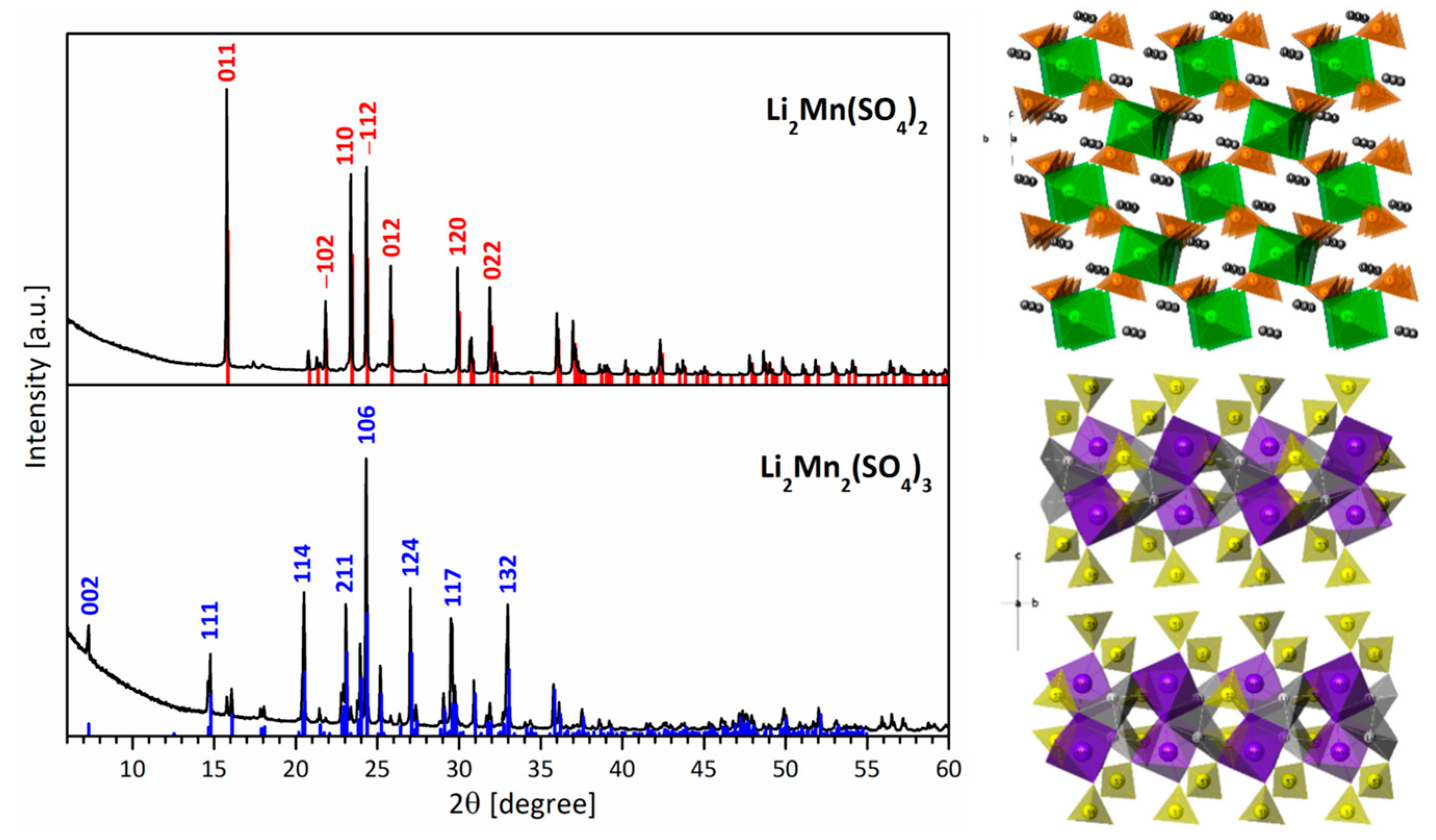
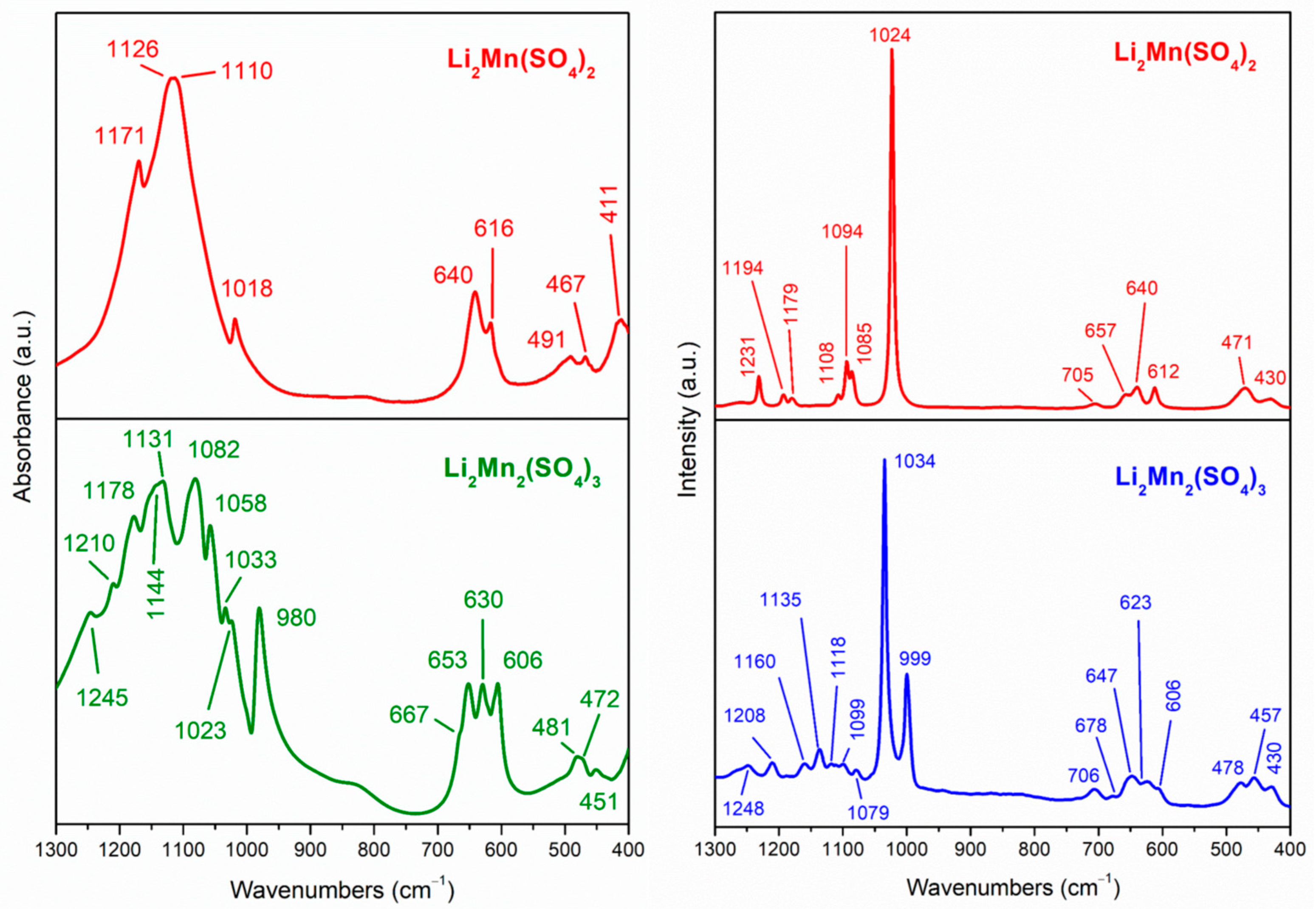
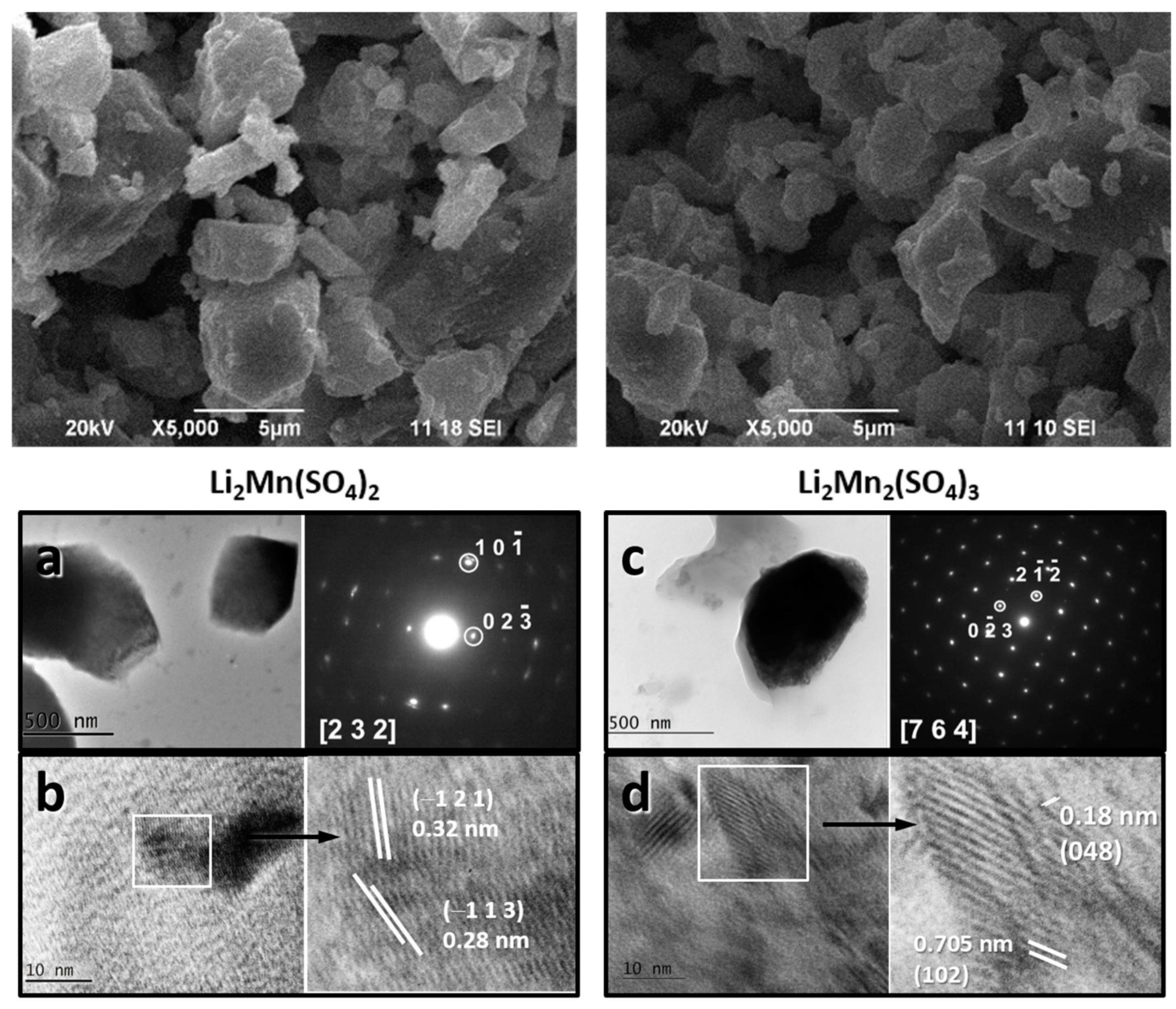
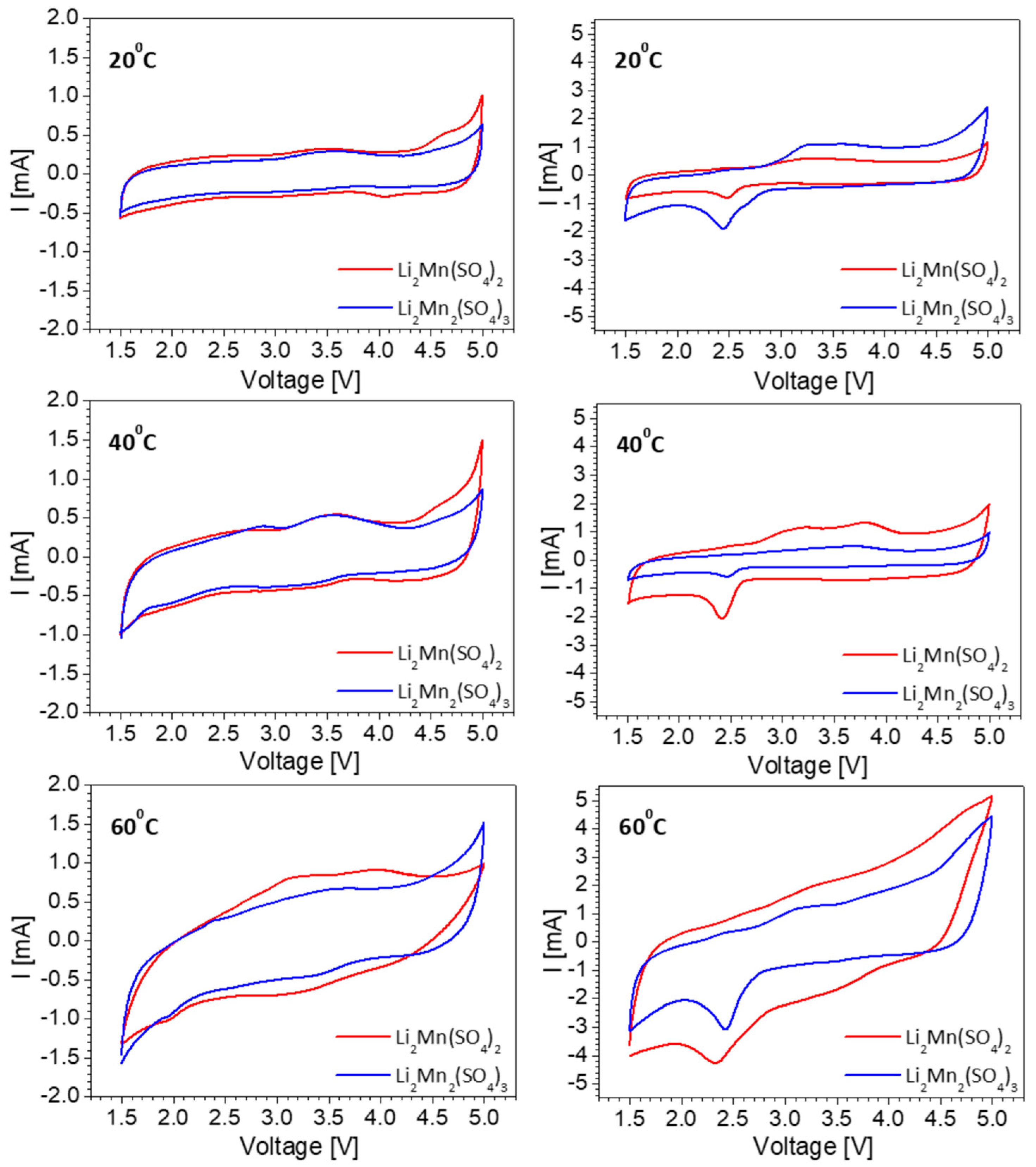
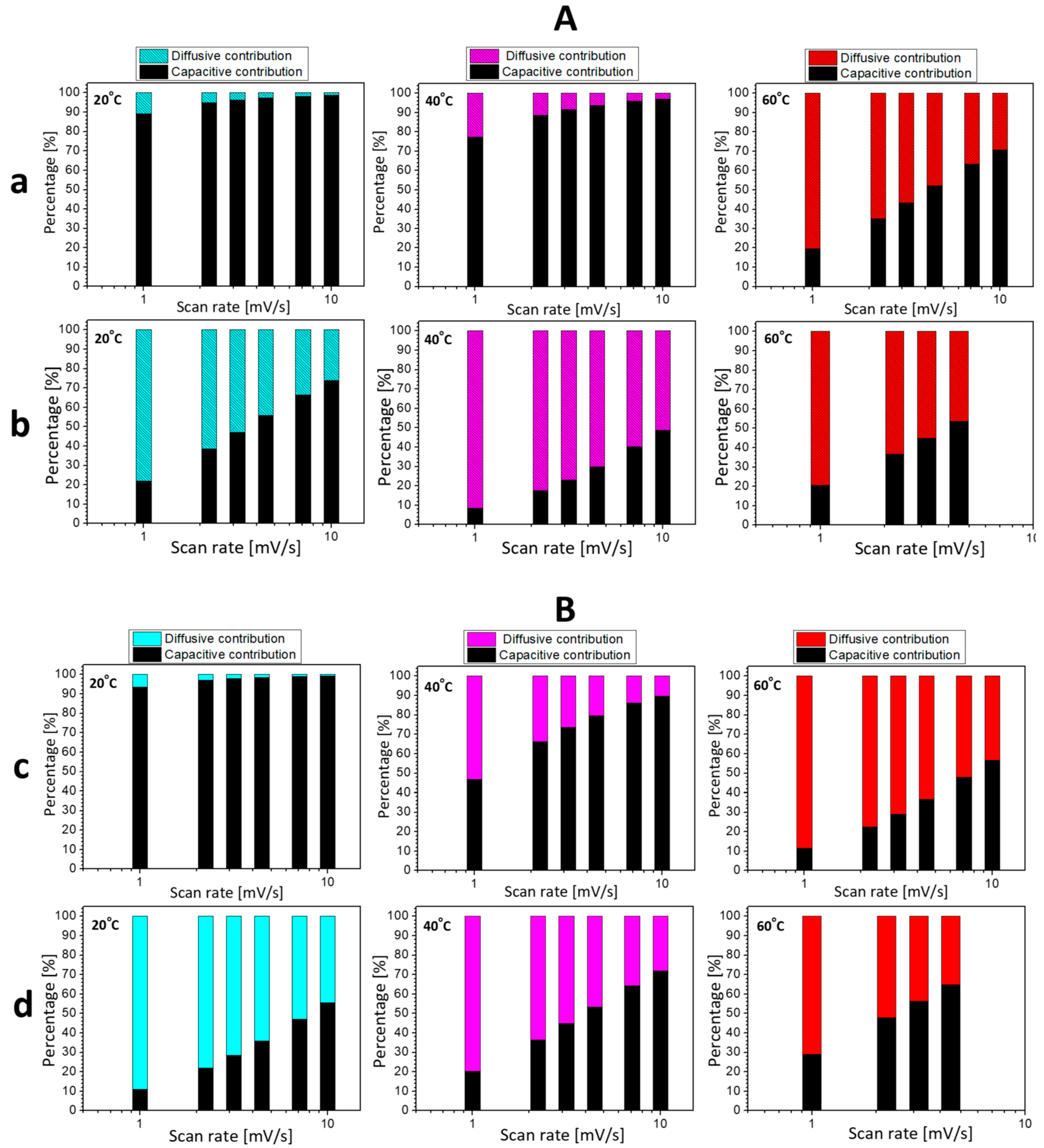
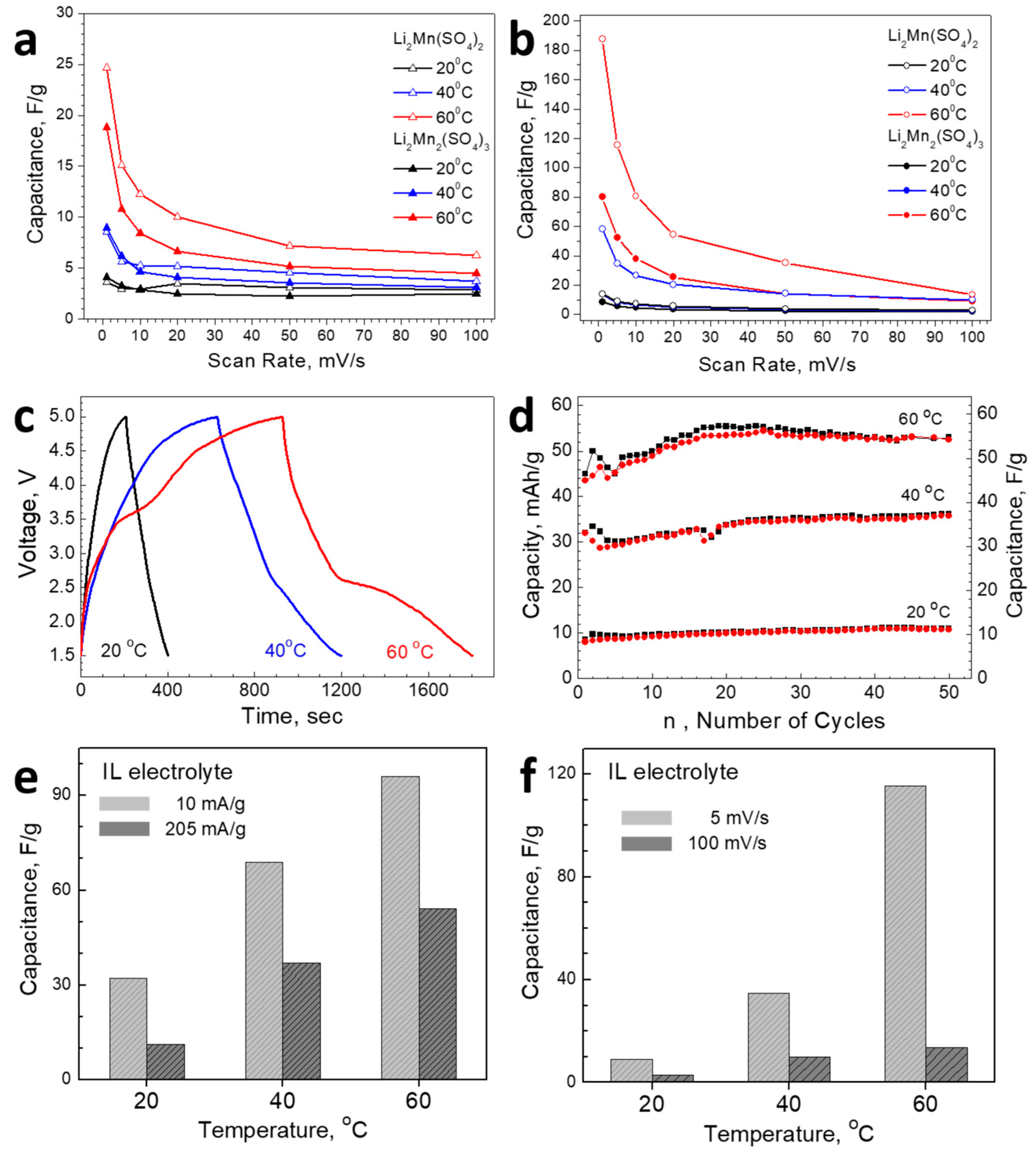

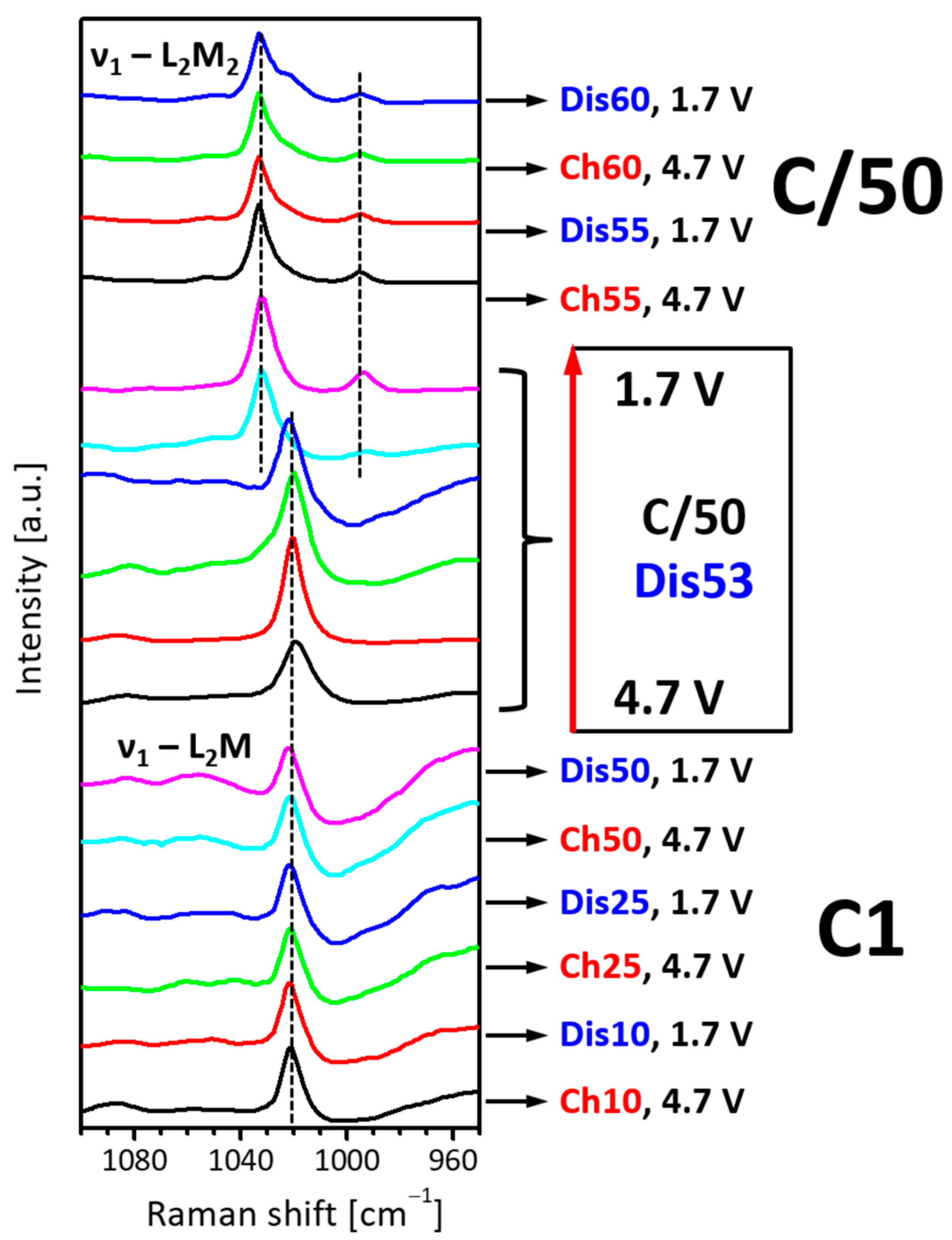


| Formula Unit | (L2M) | (L2M2) | ||
|---|---|---|---|---|
| Space group | P 21/c | Pbca | ||
| Cell parameters | ||||
| a/Å | 4.9933 | 4.9811 * | 8.6979 | 8.6862 * |
| b/Å | 8.3412 | 8.3140 * | 8.8124 | 8.7922 * |
| c/Å | 8.8586 | 8.8382 * | 24.1623 | 24.1464 * |
| α/° | 90.00 | 90.00 * | 90.00 | 90.00 * |
| β/° | 121.22 | 121.25 * | 90.00 | 90.00 * |
| γ/° | 90.00 | 90.00 * | 90.00 | 90.00 * |
| V/Å3 | 315.52 | 312.91 * | 1854.33 | 1844 * |
| L2M | L2M2 | |||
|---|---|---|---|---|
| Vibrational Mode | IR Spectra | Raman Spectra | IR Spectra | Raman Spectra |
| ν1 | 1018 | 1024 | 1033, 1023 980 | 1034, ~1020 sh 999 |
| ν2 | 491, 467 | 471, 430 | 481, 472 451 | 478, 457 430 |
| ν3 | 1171, 1126 1110 | 1108, 1094 1085 | 1178, 1144 1131, 1082 1058 | 1160, 1135 1118, 1099 1079 |
| ν4 | 640, 616 | 657, 640 612 | 667, 653 630, 606 | 678, 647 623, 606 |
Disclaimer/Publisher’s Note: The statements, opinions and data contained in all publications are solely those of the individual author(s) and contributor(s) and not of MDPI and/or the editor(s). MDPI and/or the editor(s) disclaim responsibility for any injury to people or property resulting from any ideas, methods, instructions or products referred to in the content. |
© 2023 by the authors. Licensee MDPI, Basel, Switzerland. This article is an open access article distributed under the terms and conditions of the Creative Commons Attribution (CC BY) license (https://creativecommons.org/licenses/by/4.0/).
Share and Cite
Marinova, D.; Kalapsazova, M.; Zlatanova, Z.; Mereacre, L.; Zhecheva, E.; Stoyanova, R. Lithium Manganese Sulfates as a New Class of Supercapattery Materials at Elevated Temperatures. Materials 2023, 16, 4798. https://doi.org/10.3390/ma16134798
Marinova D, Kalapsazova M, Zlatanova Z, Mereacre L, Zhecheva E, Stoyanova R. Lithium Manganese Sulfates as a New Class of Supercapattery Materials at Elevated Temperatures. Materials. 2023; 16(13):4798. https://doi.org/10.3390/ma16134798
Chicago/Turabian StyleMarinova, Delyana, Mariya Kalapsazova, Zlatina Zlatanova, Liuda Mereacre, Ekaterina Zhecheva, and Radostina Stoyanova. 2023. "Lithium Manganese Sulfates as a New Class of Supercapattery Materials at Elevated Temperatures" Materials 16, no. 13: 4798. https://doi.org/10.3390/ma16134798
APA StyleMarinova, D., Kalapsazova, M., Zlatanova, Z., Mereacre, L., Zhecheva, E., & Stoyanova, R. (2023). Lithium Manganese Sulfates as a New Class of Supercapattery Materials at Elevated Temperatures. Materials, 16(13), 4798. https://doi.org/10.3390/ma16134798









